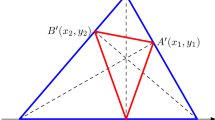Abstract
A complete solution classification of the perspective-three-point (P3P) problem is given by using the Gröbner basis method. The structure of the solution space of the polynomial system deduced by the P3P problem can be obtained by computing a comprehensive Gröbner system. Combining with properties of the generalized discriminant sequences, the authors give the explicit conditions to determine the number of distinct real positive solutions of the P3P problem. Several examples are provided to illustrate the effectiveness of the proposed conditions.
Similar content being viewed by others
References
Fischler M A and Bolles R C, Random sample consensus: A paradigm for model fitting with applications to image analysis and automated cartography, Communications of the ACM, 1981, 24(6): 381–395.
Ganapathy S, Decomposition of transformation matrices for robot vision, Pattern Recognition Letters, 1984, 2(6): 401–412.
Hu Z Y and Wu F C, A note on the number of solutions of the noncoplanar P4P problem, IEEE Transactions on Pattern Analysis and Machine Intelligence, 2002, 24(4): 550–555.
Wu Y H and Hu Z Y, PnP problem revisited, Journal of Mathematical Imaging and Vision, 2006, 24(1): 131–141.
Horaud R, Conio B, Leboulleux O, et al., An analytic solution for the perspective 4-point problem, IEEE Computer Society Conference on Computer Vision and Pattern Recognition, IEEE, 1989, 500–507.
Moreno-Noguer F, Lepetit V, and Fua P, Accurate non-iterative O(n) solution to the PnP problem, IEEE 11th International Conference on Computer Vision, 2007, 1–8.
Schweighofer G and Pinz A, Globally optimal O(n) solution to the PnP problem for general camera models, BMVC, 2008, 1–10.
Tang J, Chen W S, and Wang J, A novel linear algorithm for P5P problem, Applied Mathematics and Computation, 2008, 205(2): 628–634.
Lepetit V, Moreno-Noguer F, and Fua P, EPnP: An accurate O(n) solution to the PnP problem, International journal of computer vision, 2009, 81(2): 155–166.
Kneip L, Scaramuzza D, and Siegwart R, A novel parametrization of the perspective-three-point problem for a direct computation of absolute camera position and orientation, IEEE Conference on Computer Vision and Pattern Recognition, 2011, 2969–2976.
Haralick R M, Lee D, Ottenburg K, and Nolle M, Analysis and solutions of the three point perspective pose estimation problem, IEEE Computer Society Conference on Computer Vision and Pattern Recognition, 1991, 592–598.
Yang L, A simplified algorithm for solution classification of the perspective-three-point problem, MM Research Preprints, 1998, 17: 17–135.
Gao X S, Hou X R, Tang J L, and Cheng H F, Complete solution classification for the perspectivethree-point problem, IEEE Transactions on Pattern Analysis and Machine Intelligence, 2003, 28(8): 930–943.
Reid G, Tang J L, and Zhi L H, A complete symbolic-numeric linear method for camera pose determination, Proceedings of the 2003 International Symposium on Symbolic and Algebraic Computation, ACM Press, 2003, 215–223.
Faugère J C, Moroz G, Rouillier F, and El Din M S, Classification of the perspective-three-point problem, discriminant variety and real solving polynomial systems of inequalities, Proceedings of the 2008 International Symposium on Symbolic and Algebraic Computation, ACM Press, 2008, 79–86.
Yang L, Recent advances on determining the number of real roots of parametric polynomials, Journal of Symbolic Computation, 1999, 28(1): 225–242.
Weispfenning V, Comprehensive Gröbner bases, Journal of Symbolic Computation, 1992, 14(1): 1–29.
Yang L, Zhang J Z, and Hou X R, Nonlinear Algebraic Equation System and Automated Theorem Proving, Shanghai Scientific and Technological Education Publishing House, Shanghai, 1996 (in Chinease).
Sylvester J, On a theory of the syzygetic relations of two rational integral functions, comprising an application to the theory of Sturm’s functions, and that of the greatest algebraical common measure, Philosophical Transactions of the Royal Society of London, 1853, 407–548.
Kapur D, Sun Y, and Wang D K, A new algorithm for computing comprehensive Gröbner systems, Proceedings of the 2010 International Symposium on Symbolic and Algebraic Computation, ACM Press, 2010, 29–36.
Yang L and Xia B C, Real solution classification for parametric semi-algebraic systems, Proceeding of the A3L, 2005, 281–289.
Cox D A, Little J B, and O’shea D, Using Algebraic Geometry, Second Edition, Springer, New York, 1998.
Suzuki A and Sato Y, An alternative approach to comprehensive Gröbner bases, Journal of Symbolic Computation, 2003, 36(3): 649–667.
Montes A, A new algorithm for discussing Gröbner bases with parameters, Journal of Symbolic Computation, 2002, 33(2): 183–208.
Author information
Authors and Affiliations
Corresponding author
Additional information
This research was supported by the National Nature Science Foundation of China under Grant Nos. 11371356 and 61121062.
This paper was recommended for publication by Editor LI Hongbo.
Rights and permissions
About this article
Cite this article
Zhou, J., Wang, D. Solving the perspective-three-point problem using comprehensive Gröbner systems. J Syst Sci Complex 29, 1446–1471 (2016). https://doi.org/10.1007/s11424-015-4310-y
Received:
Revised:
Published:
Issue Date:
DOI: https://doi.org/10.1007/s11424-015-4310-y




